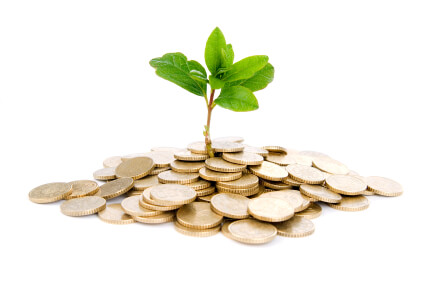This is a guest contribution by Ben Reynolds at Sure Dividend. Sure Dividend uses The 8 Rules of Dividend Investing to find high-quality dividend growth stocks suitable for long-term holding. If you’d like to contribute a guest post to The Dividend Ninja, check out our Guest Posting Guidelines.
 The ‘holy grail’ of a dividend investing is when dividend income exceeds your monthly expenses. At this point, you are completely financially free. You can retire (if you choose) on your own terms knowing your expenses are taken care of by your investment portfolio.
The ‘holy grail’ of a dividend investing is when dividend income exceeds your monthly expenses. At this point, you are completely financially free. You can retire (if you choose) on your own terms knowing your expenses are taken care of by your investment portfolio.
It sounds so simple. ‘Just build a dividend portfolio that exceeds your monthly expenses’, if it only it were that easy.
How to Achieve Dividend Retirement Goals
Like most things in life worth doing, building a dividend portfolio for retirement is not easy. It requires decades of diligence (in most cases). It requires perseverance and discipline.
This article takes a look at how to achieve your dividend retirement goals.
Step 1: Know Your Number
The first step in achieving your dividend retirement goal is to know how much income you need.
First, calculate all your planned annual retirement expenses, and sum them. This is the bare minimum of what you will need in income in retirement.
From this, subtract out any money you will receive from corporate pensions or government programs. The remainder is what you need in income from your retirement portfolio on an annual basis.
As an example, let’s say you need $40,000 a year in income from your investment portfolio. How big of a portfolio will you need to fund your retirement?
There are two methods you can use. One is the ‘4% rule’. The 4% rule says you can withdraw 4% of the value of your portfolio every year and retire comfortably. At $40,000 a year in income, this means having a portfolio valued at $1,000,000.
There’s a downside to the 4% rule, however… It requires you to sell. Selling triggers all sorts of frictional costs, including capital gains tax (in taxable situations), brokerage fees, slippage, and your time.
The hidden danger here is that you get the effects of dollar cost averaging in reverse. If your portfolio were to go down in value due to a market decline from say $1,000,000 to $800,000, you’d have to sell more than 4% of your portfolio to get the $40,000 a year you need. You’d have to sell 5% of your portfolio.
The 4% rule makes you sell more when stocks have declined in value – which is the worst time to sell. It’s the opposite of ‘buy low sell high’.
The alternative is to focus on income and growth without sacrificing safety. I believe the dividend growth approach is best in this case.
In today’s low rate environment, building a portfolio with a yield of around 3% is close to the maximum one can build while still maintaining growth and safety.
The benefit to a dividend growth portfolio is that you never have to sell. If the market crashes 50%, you still get your same dividend income (as long as your holdings don’t cut dividends).
Better yet, as the name dividend growth applies, you can expect your dividend income to appreciate year after year. In most cases, dividend growth should substantially outpace inflation.
The downside to using a dividends from a dividend growth portfolio for retirement is that it takes a more money (and therefore more time) than following the 4% rule.
If you needed the same $40,000 per year in retirement, you’d need a portfolio of $1.33 million for the dividend growth portfolio instead of $1.00 million for the 4% rule portfolio.
Of course, you could still follow the 4% rule with a dividend growth portfolio, but that increases risk as selling will have to occur.
How Long It Takes to Build
So exactly how long does it take to build a dividend growth portfolio suitable for retirement? That depends on several factors:
- Initial amount you have to invest
- Amount you are saving every month
- Annual income you will need in retirement
- Expected rate of return on dividend growth portfolio
The first 3 items above are personal. The 4th is not. What type of growth rates should dividend growth investors expect from their holding going forward?
 That depends on what is in the portfolio. For example, it’s very likely Disney (DIS) will grow its dividends faster than Consolidated Edison (ED).
That depends on what is in the portfolio. For example, it’s very likely Disney (DIS) will grow its dividends faster than Consolidated Edison (ED).
Historically speaking, the S&P 500 has returned around 7% a year after inflation (including dividends). In most studies, dividend growth stocks have done better.
For example, the Dividend Aristocrats – a group of stocks with 25+ years of consecutive dividend increases – has generated after-inflation total returns of 8.6% a year over the last decade versus 5.4% for the S&P 500.
Note: Inflation data from US Inflation Calculator, Return data from Dividend Aristocrats Fact Sheet
The other factor to consider is how low interest rates are now, and, correspondingly how high the market’s price-to-earnings ratio is. The S&P 500’s historical average price-to-earnings ratio is 15.6. It is currently at 24.0.
If interest rates and valuation multiples were to fully or partially revert to their mean, returns would be substantially lower using today as a starting point.
Accounting for this, if you shave 2 percentage points off the S&P 500’s long-term return, you get 5%. Add a point for the likely continued outperformance of high quality dividend growth stocks over the overall market, and a conservative after inflation expected growth rate for a high quality dividend growth portfolio is around 6% including dividends.
At 6% a year, your money will double in value around every 12 years. A $10,000 initial investment combined with saving $1,000 a month would take 34 years to reach over $1.33 million (enough for a sustained $40k+ year income).
You can use one of the many online investment calculators (like this one) to put in numbers to match your situation.
Final Thoughts
The most important aspect of achieving your retirement goals is to have a plan. Once you have a plan with reasonable assumptions and numbers, you can plan according by either increasing your savings rate or reducing your expenses to meet your retirement goals faster.
I believe dividend growth investing is especially beneficial for both growing a future retirement portfolio and providing growing dividend income throughout retirement. That’s because dividend growth portfolios should provide income growth in excess of inflation and current income without sacrificing safety.

That’s a pretty good article there Ben. Knowing how much you need in retirement, and how to invest your way there is very important.
Thanks, glad you liked the article!
Question about this part: The benefit to a dividend growth portfolio is that you never have to sell. If the market crashes 50%, you still get your same dividend income (as long as your holdings don’t cut dividends).
If the market crashes 50% then you may have the same dividend rate, but not the same income because the dividend rate would be of a small amount since the share’s price has dropped, correct?
Hi Jim,
Not the same dividend rate. The price and yield of a dividend stock are inversely correlated. Therefore, as a stock price declines, the dividend yield will increase. Conversely, as a stock price increases, the dividend yield will decrease:
Dividend Yield = annual dividend per share / stock’s price per share
Cheers
Avrom
Great article Ben.
Financial advisers and Investors tend to over estimate the amount of money they will require in retirement. 40 grand a year in a low tax bracket with no mortgage can really go a long ways.
Cheers
Steve